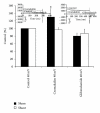ATP-Sensitive Potassium Channel Currents in Eccentrically Hypertrophied Cardiac Myocytes of Volume-Overloaded Rats
- PMID: 21845191
- PMCID: PMC3154573
- DOI: 10.1155/2011/838951
ATP-Sensitive Potassium Channel Currents in Eccentrically Hypertrophied Cardiac Myocytes of Volume-Overloaded Rats
Abstract
ATP-sensitive potassium channels (K(ATP)) protect the myocardium from hypertrophy induced by pressure-overloading. In this study, we determined the effects of these channels in volume-overloading. We compared the effects of a K(ATP) agonist and a K(ATP) antagonist on sarcolemmal transmembrane current density (pA/pF) clamped at 20 mV increments of membrane potential from -80 to +40 mV in ventricular cardiac myocytes. The basal outward potassium pA/pF in myocytes of volume-overloaded animals was significantly smaller than that in the myocytes of sham-operated controls. Treatment of the control myocytes with the K(ATP) agonist cromakalim increased pA/pF significantly. This increase was blocked by the K(ATP) antagonist glibenclamide. Treatment of the hypertrophied myocytes from volume-overloaded animals with cromakalim and in the presence and absence of glibenclamide did not change pA/pF significantly. These findings suggest that eccentrically hypertrophied cardiac myocytes from volume-overloading may be unresponsive to specific activation/inactivation of K(ATP) and that dysfunctional K(ATP) may fail to protect the myocardium from left ventricular hypertrophy associated with volume-overloading.
Figures



Similar articles
-
Electrical remodeling of membrane ionic channels of hypertrophied ventricular myocytes from spontaneously hypertensive rats.Chin Med J (Engl). 2000 Jul;113(7):584-7. Chin Med J (Engl). 2000. PMID: 11776022
-
A role for a glibenclamide-sensitive, relatively ATP-insensitive K+ current in regulating membrane potential and current in rat aorta.Cardiovasc Res. 1999 Nov;44(2):429-35. doi: 10.1016/s0008-6363(99)00223-0. Cardiovasc Res. 1999. PMID: 10690319
-
Effect of fosinopril on the transient outward potassium current of hypertrophied left ventricular myocardium in the spontaneously hypertensive rat.Naunyn Schmiedebergs Arch Pharmacol. 2014 May;387(5):419-25. doi: 10.1007/s00210-014-0956-6. Epub 2014 Jan 19. Naunyn Schmiedebergs Arch Pharmacol. 2014. PMID: 24441766
-
Potassium channel openers act through an activation of ATP-sensitive K+ channels in guinea-pig cardiac myocytes.Pflugers Arch. 1989 Sep;414(6):669-75. doi: 10.1007/BF00582134. Pflugers Arch. 1989. PMID: 2510125
-
[ATP-Sensitive potassium channel function during the progression of pressure overload heart failure in rats].Zhonghua Xin Xue Guan Bing Za Zhi. 2010 Mar;38(3):220-4. Zhonghua Xin Xue Guan Bing Za Zhi. 2010. PMID: 20450563 Chinese.
Cited by
-
Isosteviol Sensitizes sarcKATP Channels towards Pinacidil and Potentiates Mitochondrial Uncoupling of Diazoxide in Guinea Pig Ventricular Myocytes.Oxid Med Cell Longev. 2016;2016:6362812. doi: 10.1155/2016/6362812. Epub 2016 Feb 2. Oxid Med Cell Longev. 2016. PMID: 26949448 Free PMC article.
-
Effects of IGF-1 on I(K) and I(K1) Channels via PI3K/Akt Signaling in Neonatal Cardiac Myocytes.Int J Cell Biol. 2012;2012:712153. doi: 10.1155/2012/712153. Epub 2012 Jun 18. Int J Cell Biol. 2012. PMID: 22761619 Free PMC article.
References
-
- Kannel WB. Incidence and epidemiology of heart failure. Heart Failure Reviews. 2000;5(2):167–173. - PubMed
-
- Turina J, Hess O, Sepulcri F, Krayenbuehl HP. Spontaneous course of aortic valve disease. European Heart Journal. 1987;8(5):471–483. - PubMed
-
- Li GR, Dong MQ. Pharmacology of cardiac potassium channels. Advances in Pharmacology. 2010;59:93–134. - PubMed
-
- Kolár F, Neckár J, Ostádal B. MCC-134, a blocker of mitochondrial and opener of sarcolemmal ATP-sensitive K+ channels, abrogates cardioprotective effects of chronic hypoxia. Physiological Research. 2005;54(4):467–471. - PubMed
Grants and funding
LinkOut - more resources
Full Text Sources

